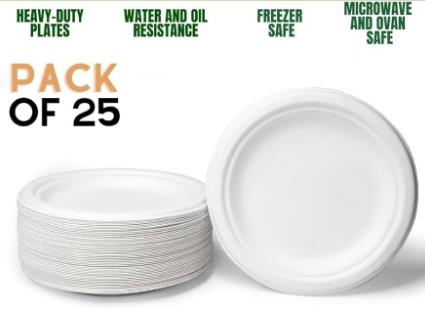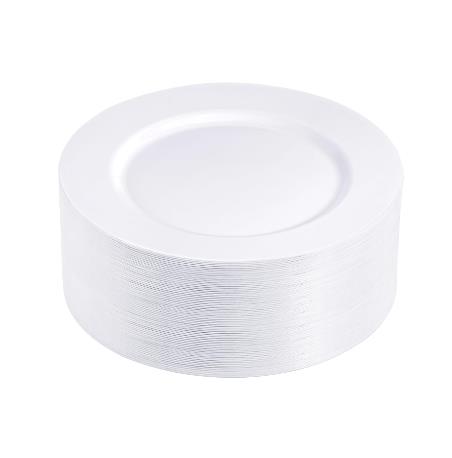
Content Menu
● Understanding BPA
● The Safety of GP Disposable Plates
● Types of Disposable Plates
● Health Risks Associated with Disposable Plates
● Consumer Concerns and Recommendations
● Environmental Considerations
● The Role of Regulations
● Understanding Alternatives to BPA
>> The Risks of BPS and BPF
● Consumer Awareness and Education
● Conclusion
● FAQ
>> 1. What types of materials are used in GP disposable plates?
>> 2. Are there any health risks associated with using plastic plates?
>> 3. How can I ensure I'm purchasing safe disposable plates?
>> 4. Can I microwave food on paper plates?
>> 5. What should I do if I'm concerned about chemical exposure from disposable dinnerware?
● Citations:
In recent years, the concern over the safety of disposable plates, particularly regarding chemical leaching into food, has gained significant attention. One of the most frequently discussed chemicals in this context is Bisphenol A (BPA). This article will explore whether GP (Georgia-Pacific) disposable plates contain BPA, the implications of BPA exposure, and alternative options for consumers seeking safer disposable dinnerware.

Understanding BPA
What is BPA?
BPA, or Bisphenol A, is an industrial chemical that has been used since the 1950s to manufacture certain plastics and resins. It is commonly found in polycarbonate plastics and epoxy resins, which are often used in containers that store food and beverages. Concerns about BPA stem from research indicating that it can seep into food or drinks from containers made with BPA, potentially leading to various health issues. These include hormonal disruptions, reproductive harm, and possible links to conditions such as obesity and diabetes.
The Safety of GP Disposable Plates
Do GP Disposable Plates Contain BPA?
According to Georgia-Pacific, their Dixie® products, which include disposable plates and bowls, do not contain BPA. The company explicitly states that BPA is not used in nor intentionally added to any of their products. This assurance is crucial for consumers who are concerned about the potential health risks associated with BPA exposure.
Types of Disposable Plates
When considering disposable plates, it's essential to understand the different types available on the market:
- Plastic Plates: Often made from polystyrene or polypropylene. While many brands advertise themselves as "BPA-free," some may still contain other harmful chemicals.
- Paper Plates: Typically made from recycled paper or fiber. Some paper plates are coated with substances that can leach chemicals into food when heated or in contact with fatty foods.
- Biodegradable Plates: Made from materials like sugarcane or bamboo, these are often marketed as more environmentally friendly options.
Health Risks Associated with Disposable Plates
Potential Chemicals in Disposable Plates
While BPA is a primary concern, other chemicals can also leach from disposable plates:
- PFAS (Per- and Polyfluoroalkyl Substances): These chemicals are often used for their grease-resistant properties but are linked to various health issues, including cancer and immune system effects.
- Styrene: Found in polystyrene products (often labeled as Styrofoam), styrene is classified as a possible human carcinogen by the EPA.
- BPS (Bisphenol S): A common substitute for BPA that may have similar health effects.

Consumer Concerns and Recommendations
Many consumers are understandably cautious about using disposable plates due to the potential for harmful chemical exposure. Here are some recommendations for safer choices:
- Look for BPA-Free Labels: Always check for labels indicating that products are free from BPA and other harmful chemicals.
- Choose Biodegradable Options: Products made from natural materials like palm leaves or sugarcane typically have fewer chemical concerns.
- Avoid Heating Plastic: Do not microwave food in plastic containers unless they are specifically labeled as microwave-safe.
Environmental Considerations
In addition to health concerns, environmental impact is another critical factor when choosing disposable dinnerware. Many disposable products contribute significantly to landfill waste. Here are some eco-friendly alternatives:
- Compostable Plates: Made from organic materials that break down naturally.
- Recyclable Products: Ensure the plates can be recycled after use.
The Role of Regulations
Current Regulations on BPA
In response to growing health concerns regarding BPA, several regulatory agencies worldwide have implemented restrictions on its use. For instance:
- In the United States, the FDA has banned BPA in baby bottles and sippy cups.
- The European Union has placed strict regulations on the use of BPA in food contact materials.
These regulations aim to reduce consumer exposure to harmful chemicals while promoting safer alternatives in packaging and food storage solutions.
Understanding Alternatives to BPA
While many manufacturers have shifted towards "BPA-free" products, it's essential to recognize that some substitutes may not be significantly safer. Research has shown that certain alternatives like BPF (Bisphenol F) and BPS can exhibit similar endocrine-disrupting properties as BPA itself.
The Risks of BPS and BPF
Recent studies indicate that these substitutes may still pose health risks comparable to those associated with BPA:
- BPF: Similar in structure to BPA, BPF has been found to activate estrogen receptors in a manner similar to BPA. This raises concerns about its potential effects on hormone regulation and reproductive health.
- BPS: Although marketed as a safer alternative, research suggests that BPS can accumulate in biological systems and disrupt endocrine functions similarly to its predecessor.
Understanding these risks emphasizes the need for thorough testing of all chemical substitutes before they enter consumer markets.
Consumer Awareness and Education
As consumers become more aware of these issues, education plays a crucial role in making informed choices regarding disposable tableware. Here are some strategies for enhancing consumer knowledge:
- Research Brands: Investigate brands' claims regarding their products' safety and environmental impact. Look for transparency in ingredient sourcing and manufacturing processes.
- Stay Informed: Follow updates from reputable health organizations regarding new research findings related to chemical safety in consumer products.
- Advocate for Change: Support initiatives aimed at improving regulations on chemical use in consumer goods. Engaging with local representatives can help push for stricter safety standards.
Conclusion
In summary, GP disposable plates do not contain BPA according to Georgia-Pacific's claims. However, consumers should remain vigilant about other potential harmful chemicals present in disposable dinnerware. Opting for safer alternatives such as biodegradable or compostable plates can mitigate health risks while also benefiting the environment. As awareness continues to grow about chemical safety in food packaging, consumers can make informed decisions that prioritize both health and sustainability.

FAQ
1. What types of materials are used in GP disposable plates?
GP disposable plates are primarily made from paper and high-quality food-grade plastic that complies with safety regulations.
2. Are there any health risks associated with using plastic plates?
Yes, certain plastics can leach harmful chemicals like BPA and PFAS into food, especially when heated.
3. How can I ensure I'm purchasing safe disposable plates?
Look for products labeled as "BPA-free" and choose biodegradable options whenever possible.
4. Can I microwave food on paper plates?
Some paper plates are microwave-safe; however, always check the packaging for specific instructions.
5. What should I do if I'm concerned about chemical exposure from disposable dinnerware?
Consider using glass or stainless steel containers for heating food and limit the use of disposable products when possible.
Citations:
[1] https://www.gppro.com/gp/gppro/USD/Categories/Paper-Plates-and-Bowls/GP-PRO-DIXIE-BASIC%C2%AE-LIGHT-WEIGHT-PAPER-PLATE-8-1-2IN-WHITE-INDIVIDUALLY-WRAPPED-500-PLATES/p/DBP09WR1
[2] https://www.dixie.com/faq
[3] https://www.mamavation.com/product-investigations/paper-plates.html
[4] https://www.health.state.mn.us/communities/environment/risk/chemhazard/bisphenola.html
[5] https://www.epa.gov/sciencematters/are-bpa-substitutes-any-safer-bpa
[6] https://www.ucf.edu/news/how-safe-are-bpa-free-plastics/
[7] https://lboffice.com/georgia-pacific-corp/dixie-8-12-medium-weight-paper-plates-by-gp-pro/DXEUX9WSCT/p
[8] https://www.gppackaging.com/claims/
[9] https://www.eurekalert.org/news-releases/1065261
[10] https://www.gppro.com/gp/products/plates-platters-and-bowls

















